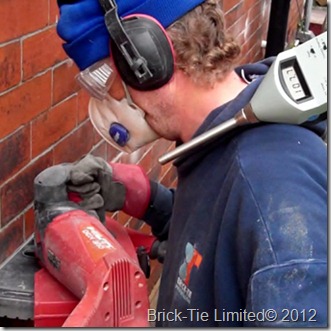Okay so this is a technical blog on preservation which includes damp proofing and wall tie replacement, but noise, what’s that got to do with it?
I’m just over half way through my Nebosh (National Examination Board in Occupational Safety and Health), general certificate course and for a bit of study I carried out a noise assessment on a wall tie contract in Leeds the other day.
I must say the I was quite surprised. The lower exposure action level for noise in the work place is 80dB (Noise at Work Regulations 2005), with the Upper exposure action level at 85dB. With Nigel Deane and his fancy noise meter on site we measured 107 dB at the ear of an operator using a Hilti wall chasing machine and 94dB at the ear of a wall tie installation technician.
At the 80dB level employees must be advised of the situation and supplied with ear protection if they request it. Of course I supply all my staff with ear protection and insist that they wear it. The thing is, at 85dB this is a mandatory hearing protection zone, which means that the employer must enforce the wearing of ear protection – if the staff don’t wear it, it is the employers fault (and employees too according to the Health and Safety at work etc Act 1974 – Section 7).
Now then, five decibels above the lower limit doesn’t sound much, but bear in mind that the decibel scale is a logarithmic one so for every 3dB increase in noise level the amplitude or ‘loudness’ is doubled. That means that 85dB is nearly four times louder than 80dB and 107dB is 0ver 512 times louder!
Nigel then demonstrated the more detailed and accurate ‘full octave band analysis’ method. Which involves measuring the noise in separate frequencies so that the effects can be more accurately judged and this matched to the correct controls and PPE.
I was then able to check out the hearing protection afforded by the PPE we use and then make sure that it reduced the noise at the ear canal to an acceptable level.
The noise assessment is a legal requirement and employers must do this (must is picked straight out of the regulations so this is an absolute duty), if they employ workers subjected to noise at these levels. I’d say that all PCA members and other damp proofing companies make as much noise as my chaps do, so my advice is:
“If you haven’t carried out a noise assessment yet – do so”.
I am grateful to Nigel Deane of ND Safety for his advice and help. Nigel is is delivering my Nebosh course as well as the NVQ 5 in Occupational Health & Safety which I am studying for. I can’t recommend Nigel enough, he’s been making health & Safety fun and fascinating over the past few weeks; something I would never have believed possible. He’s dedicated, knowledgeable and clearly loves his work.
Dry Rot.
